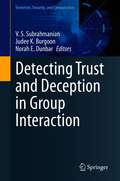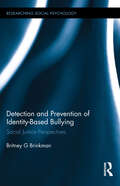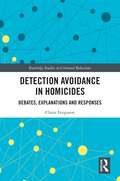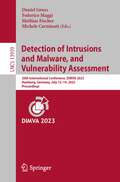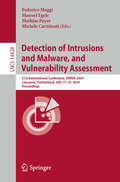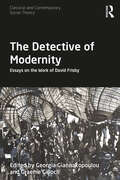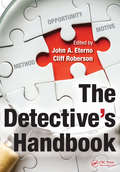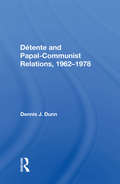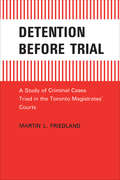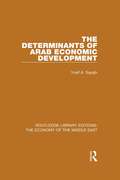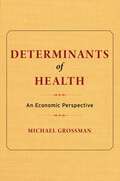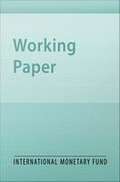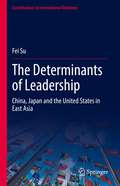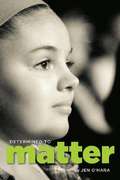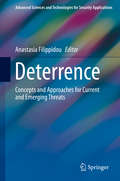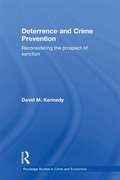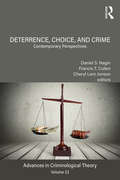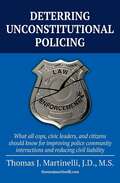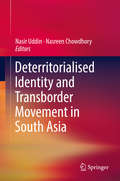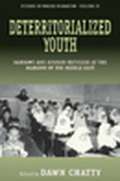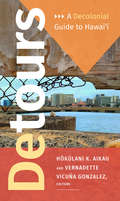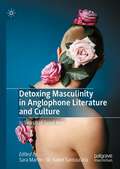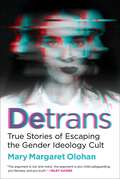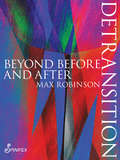- Table View
- List View
Detecting Trust and Deception in Group Interaction (Terrorism, Security, and Computation)
by V. S. Subrahmanian Judee K. Burgoon Norah E. DunbarThis book analyzes the multimodal verbal and nonverbal behavior of humans in both an artificial game, based on the well-known Mafia and Resistance games, as well as selected other settings. This book develops statistical results linking different types of facial expressions (e.g. smile, pursed lips, raised eyebrows), vocal features (e.g., pitch, loudness) and linguistic features (e.g., dominant language, turn length) with both unary behaviors (e.g. is person X lying?) to binary behaviors (Is person X dominant compared to person Y? Does X trust Y? Does X like Y?). In addition, this book describes machine learning and computer vision-based algorithms that can be used to predict deception, as well as the visual focus of attention of people during discussions that can be linked to many binary behaviors. It is written by a multidisciplinary team of both social scientists and computer scientists.Meetings are at the very heart of human activity. Whether you are involved in a business meeting or in a diplomatic negotiation, such an event has multiple actors, some cooperative and some adversarial. Some actors may be deceptive, others may have complex relationships with others in the group. This book consists of a set of 11 chapters that describe the factors that link human behavior in group settings and attitudes to facial and voice characteristics.Researchers working in social sciences (communication, psychology, cognitive science) with an interest in studying the link between human interpersonal behavior and facial/speech/linguistic characteristics will be interested in this book. Computer scientists, who are interested in developing machine learning and deep learning based models of human behavior in group settings will also be interested in purchasing this book.
Detection and Prevention of Identity-Based Bullying: Social Justice Perspectives (Researching Social Psychology)
by Britney G BrinkmanBullying in schools has become the focus of a growing body of literature; however, much of that work diminishes the role of social context, social identities, and prejudices despite extensive research evidence suggesting that many victims of bullying are targeted because of an aspect of their social identity. This book demonstrates how the prevention and intervention of this phenomenon, termed identity-based bullying, is a social justice issue. Expanding beyond bullying prevention that focuses on individual perpetrators, the book examines identity-based bullying in schools as a microcosm of larger systemic tensions and conflicts. The author utilizes a social constructivist perspective to understand the experiences of children as active agents in their own lives. She also provides an international framework to describe the impact of culture, social structures, and politics from the US and the UK. Challenges and barriers to addressing identity-based bullying are explored and recommendations are made for best practices for teachers, administrators, and mental health professionals to prevent and respond to identity-based bullying.
Detection Avoidance in Homicide: Debates, Explanations and Responses (Routledge Studies in Criminal Behaviour)
by Claire FergusonDetection Avoidance in Homicides: Debates, Explanations and Responses presents theory and research on how offenders avoid detection and the challenges and opportunities these efforts pose to investigators. From a scholarly perspective, the book presents a continuing history of research on detection avoidance by offenders, discusses the features of complex death investigations involving detection avoidance, and critiques the current frameworks used for conceptualizing these behaviors. Dr. Ferguson focuses on the key debates in the literature, argues for collaborations between researchers and practitioners to remedy siloing, and explores the reality of detection avoidance in homicides as complex and multifaceted. While detection avoidance behaviors have the potential to negatively impact sudden death investigations and frustrate criminal investigations specifically, their use also creates broader problems. These include many problematic effects on family members of the deceased, police officers, police agencies and the communities they serve. Offenders choosing to use detection avoidance behaviors challenges the efficient use of public resources, puts at risk the successful adjudication of homicides, and creates a public safety issue. The book explains detection avoidance using learning, situational, individual and gender-based theories, including proposing whether it may be a form of coercive control used by intimate partner abusers. Finally, how detection avoidance by offenders is recognized and responded to in sudden death investigations is addressed, with specific reference to useful examples of policy reform implemented by various police agencies internationally. Providing research and theory to explain detection avoidance and best practice for responding to it, this book will be of great interest to students and scholars of criminology, forensic science and psychology. It will also be useful to professionals working with homicide offenders.
Detection of Intrusions and Malware, and Vulnerability Assessment: 20th International Conference, DIMVA 2023, Hamburg, Germany, July 12–14, 2023, Proceedings (Lecture Notes in Computer Science #13959)
by Daniel Gruss Federico Maggi Mathias Fischer Michele CarminatiThis book constitutes the proceedings of the 20th International Conference on Detection of Intrusions and Malware, and Vulnerability Assessment, DIMVA 2023, held in Hamburg, Germany, in July 2023. The 12 full papers and 1 short paper presented in this volume were carefully reviewed and selected from 43 submissions. The papers are organized in thematical sections named: Side Channels Attacks; Security and Machine Learning; Cyber Physical System Security; Security Issues when Dealing with Users; Analysis of Vulnerable Code; Flow Integrity and Security.
Detection of Intrusions and Malware, and Vulnerability Assessment: 21st International Conference, DIMVA 2024, Lausanne, Switzerland, July 17–19, 2024, Proceedings (Lecture Notes in Computer Science #14828)
by Federico Maggi Mathias Payer Michele Carminati Manuel EgeleThis book constitutes the proceedings of the 21st International Conference on Detection of Intrusions and Malware, and Vulnerability Assessment, DIMVA 2024, held in Lausanne, Switzerland, during July 17–19, 2024. The 22 full papers and 6 short paper presented in this volume were carefully reviewed and selected from 110 submissions. The papers are organized in thematical sections named: vulnerability detection and defense; malware and threats; mobile and web application security; AI for security; hardware and firmware security; cyber physical systems and IoT.
The Detective of Modernity: Essays on the Work of David Frisby (Classical and Contemporary Social Theory)
by Georgia Giannakopoulou and Graeme GillochThis book explores the thought of – and is dedicated to – David Frisby, one of the leading sociologists of the late twentieth and early twenty-first centuries. Presenting original examinations of his unique social theory and underlining his interdisciplinary approach to the critical interpretation of modern metropolitan society and culture, it emphasises Frisby’s legacy in highlighting the role of the social researcher as a collector, reader, observer, detective and archivist of the phenomena and ideas that exemplify the modern metropolis as society. With contributions from sociologists, cultural theorists, historians of the city, urban geographers and designers, and architectural historians and theorists, The Detective of Modernity constitutes a wide-ranging engagement with Frisby’s profound legacy in social and cultural theory.
The Detective's Handbook
by Cliff Roberson John A. EternoThe Detective‘s Handbook details the vital information law enforcement officers need to know to become better detectives. Since all essential aspects of detective work cannot be covered in a single volume, the editors have selected 20 of the most critical issues detectives face in their day-to-day work and present them in separate chapters.Using a
Detente And Papal-communist Relations, 1962-1978
by Dennis J. DunnThe Catholic Church and the various communist governments of Europe have been vitally involved in the process of detente, moving from the silence of the Cold War to the stage of dialogue despite the persistence of religious persecution in the communist world. In this detailed study of recent developments, Professor Dunn discusses the motivating factors in papal-communist relations and chronicles the major events in détente policy in the Soviet Union and those countries of Eastern Europe—Poland, Hungary, Czechoslovakia, and Yugo-slavia--Where the Catholic Church is at least nominally the religion of 30% or more of the population.
Detention Before Trial: A Study of Criminal Cases Tried in the Toronto Magistrates' Courts
by Martin L. FriedlandDetention before trial has been one of the most neglected areas in the whole administration of criminal justice. In the past, attention has been focussed almost exclusively on detention after trial (i.e. sentencing), which touches the lives of significantly fewer persons than detention before trial. There has been no previous examination in Canada of the utility or effectiveness of its operation. This study will fill an important need by documenting statistically the extent and nature of custody before trial in the Toronto Magistrates' Courts, where the overwhelming majority of citizens charged with criminal offences in the Toronto area are tried. Although the study is primarily directed at practices before trial in Toronto, many of these practices can be found in other cities throughout North America. Specific areas of importance which were investigated here include the use of the summons; the extent to which accused persons are detained in custody both before and after the first court appearance; bail-setting practices and the ability to raise bail; the activities of professional bondsmen; the enforcement of penalties for absconding; and the relationship between custody and the outcome of the trial. Much of the presentation of the data is descriptive, but attempts are made throughout the study to prove statistically the existence of casual relationships. The result is a work which brings together in lucid and scholarly form important evidence which will be valuable to lawyers and all who are professionally concerned with social problems, and of interest to everyone with a regard for the administration of justice.
The Determinants of Arab Economic Development (Routledge Library Editions: The Economy of the Middle East)
by Yusuf A. SayighThis book explores in depth the factors determining economic development in the Arab region. The particular factors relevant to the Arab world are also set within the context of the broad political economy of underdevelopment. The factors are identified as comprising three main groups: economic, political administrative and socio-cultural; petroleum and regional Arab economic development are examined separately. The force and operation of each determinant is further assessed in the context of the individual countries, from which the author is able to arrive at some important conclusions concerning the interaction of these determinants and their impact upon development. First published in 1978.
Determinants of Health: An Economic Perspective
by Michael GrossmanThis collection of Michael Grossman’s most important papers adds essential background and depth to his work on economic determinants of public health. Each of the book’s four sections includes an introduction that contextualizes the issues and addresses the larger stakes of his work. An afterword discusses the significance of Grossman’s approach for subsequent research on health economics, as well as the work others have done to advance and extend his innovative perspective.Determinants of Health explains how the economic choices people make influence health and health behaviors. It begins with a section on the theoretical underpinnings and empirical results of Grossman’s groundbreaking health economics model, first introduced in the 1970s, followed by essays on the relationship between health and schooling; determinants of infant health, with a special emphasis on public policies and programs; and the economics of unhealthy behaviors. Grossman treats health as a form of human capital. He shows that public policies and programs that determine the price and availability of key inputs have critical effects on outcomes ranging from birth weight and infant mortality to cigarette smoking, alcohol abuse, illegal drug use, and obesity. Grossman’s approach has led to a major stream of literature in the field, sparking contributions by the world’s leading health economists, including Joseph Newhouse, Jonathan Gruber, Amy Finkelstein, Michael Greenstone, and David Cutler. His clarity on the role that economics play in people’s good and bad health choices is immensely valuable to the debate over how we legislate and spend on health.
Determinants of Investment Grade Status in Emerging Markets
by Laura JaramilloA report from the International Monetary Fund.
The Determinants of Leadership: China, Japan and the United States in East Asia (Contributions to International Relations)
by Fei SuThis book investigates the determinants of leadership in East Asia, emphasizing the significance of followership in the success and failure of leadership projects proposed by China, Japan, and the United States. While doing so, it answers a central question in the field of international relations: Why do potential leader countries succeed in obtaining potential followers in some instances, but fail to do so in other instances? Employing an inclusive leadership and societal approach, the book investigates how the leading countries motivate followership in East Asian economic and security dynamics. It analyzes how Chinese, Japanese and American leadership obtained acceptance from potential followers, focusing on the significance of domestic politics of potential follower countries in shaping their governmental preferences and generating followership. The book features empirical evidence in six case studies, covering topics such as the successful Chinese endeavor of South Korea joining the Chinese initiative for the Asian Infrastructure and Investment Bank (AIIB), the failed US attempt to prevent South Korea from doing so, the US's success to convince Japan to join the Trans-Pacific Partnership (TPP), the failed Japanese strive for winning South Korea's support for Japan’s bid for a permanent seat at the UN Security Council (UNSC), the Chinese failure at obtaining the Philippines’ backing of the Chinese aspirations in the South China Sea (SCS) during the Aquino Presidency, and, finally, the Chinese success one the same effort during the Duterte presidency.The book will appeal to students, scholars, and researchers of international relations interested in a better understanding of leadership determinants in East Asia, Global Power Shift, foreign policy, as well as East Asian economic and security dynamics.
Determinants of the Death Penalty: A Comparative Study of the World (Routledge Research in Comparative Politics #Vol. 8)
by Carsten AnckarDeterminants of the Death Penalty seeks to explain the phenomenon of capital punishment - without recourse to value judgements - by identifying those characteristics common to countries that use the death penalty and those that mark countries which do not. This global study uses statistical analysis to relate the popularity of the death penalty to physical, cultural, social, economical, institutional, actor oriented and historical factors. Separate studies are conducted for democracies and non-democracies and within four regional contexts. The book also contains an in-depth investigation into determinants of the death penalty in the USA.
Determined to Matter
by Dan O'Hara Jen O'HaraShannon O'Hara, skating down the ice chasing after the puck, comes face to face with a larger-than-life opposing team player. Never one to back down from anything, barely five feet fall, Shannon tangles with the player and ends up with a penalty. As she sits in the penalty box-only thinking about getting out in two minutes-no one would ever imagine that this beautiful, vibrant, and competitive young spirit will be gone in 54 days. The devastating news that 12-year-old Shannon is diagnosed with an inoperable brain tumor is unfathomable, surreal, and unimaginable. This is the raw and emotional story of the O'Hara's as they prepare for the fight of their lives, and their ultimate loss.Written and inspired by a blog that Dan and Jen O'Hara wrote to keep in touch with their family, friends, and supporters near and far, the story follows the yearlong battle from diagnosis to death and exemplifies how to live the "new normal" every day, no matter what it entails. Shannon's struggle reveals why family, faith, and hope are so important in our daily lives and how the support of a community plays such a vital role through the good times and especially the bad.
Deterrence: Concepts and Approaches for Current and Emerging Threats (Advanced Sciences and Technologies for Security Applications)
by Anastasia FilippidouThrough the examination of different themes and subjects the book provides an in depth analysis of the concept of deterrence and its utility in dealing effectively with current threats. Although the concept of deterrence precedes the Cold War, in modern times and in its traditional form deterrence is seen as the product of the Cold War, which transformed 'narrow' deterrence approaches into widespread orthodoxy. Increasingly however emerging threats and challenges call into question the traditional concept of deterrence. There are many elements that challenge the concept of deterrence and its effectiveness. For instance it is not just that the concept can be ambiguous and broad, but also there have to be a number of conditions for it to be successfully implemented.This collection contributes to a growing field of research in a relatively under-studied area of interrogating the concept of deterrence itself through a multi-disciplinary approach. Through the use of primary and secondary sources, as well as interviews, this book covers a wide range of disciplinary approaches on deterrence and the contributors cover a broad array of subjects. The research assembled here focuses on deterring extremism, conflict resolution and diplomacy, investigating technological developments, effects of globalisation, social movements, economics, the relationship of resilience to effective deterrence, and the associated complexity of contemporary interdependencies to create a contextualised concept of modern deterrence. Social science and historical methodologies are utilized to gain a comprehensive cross-section of analysis that will reveal the strengths and weaknesses of the use of deterrence as a national security strategy, as well as highlighting the various types of power available for use by the state to create multi-faceted deterrence in order to deal effectively and efficiently with complex emerging challenges.
Deterrence and Crime Prevention: Reconsidering the Prospect of Sanction (Routledge Studies In Crime And Economics Ser.)
by David M. KennedyDeterrence is at the heart of the preventive aspiration of criminal justice. Deterrence, whether through preventive patrol by police officers or stiff prison sentences for violent offenders, is the principal mechanism through which the central feature of criminal justice, the exercise of state authority, works – it is hoped -- to diminish offending and enhance public safety. And however well we think deterrence works, it clearly often does not work nearly as well as we would like – and often at very great cost. Drawing on a wide range of scholarly literatures and real-world experience, Kennedy argues that we should reframe the ways in which we think about and produce deterrence. He argues that many of the ways in which we seek to deter crime in fact facilitate offending; that simple steps such as providing clear information to offenders could transform deterrence; that communities may be far more effective than legal authorities in deterring crime; that apparently minor sanctions can deter more effectively than draconian ones; that groups, rather than individual offenders, should often be the focus of deterrence; that existing legal tools can be used in unusual but greatly more effective ways; that even serious offenders can be reached through deliberate moral engagement; and that authorities, communities, and offenders – no matter how divided – share and can occupy hidden common ground. The result is a sophisticated but ultimately common-sense and profoundly hopeful case that we can and should use new deterrence strategies to address some of our most important crime problems. Drawing on and expanding on the lessons of groundbreaking real-world work like Boston’s Operation Ceasefire – credited with the "Boston Miracle" of the 1990s – "Deterrence and Crime Prevention" is required reading for scholars, law enforcement practitioners, and all with an interest in public safety and the health of communities.
Deterrence, Choice, and Crime, Volume 23: Contemporary Perspectives (Advances in Criminological Theory)
by Daniel S. Nagin Francis T. Cullen Cheryl Lero JonsonDeterrence, Choice, and Crime explores the various dimensions of modern deterrence theory, relevant research, and practical applications. Beginning with the classical roots of deterrence theory in Cesare Beccaria’s profoundly important contributions to modern criminological thought, the book draws out the many threads in contemporary criminology that are explicitly mentioned or at least hinted by Beccaria. These include sanction risk perceptions and their behavioral consequences, the deterrent efficacy of the certainty versus the severity of punishment, the role of celerity of punishment in the deterrence process, informal versus formal deterrence, and individual differences in deterrence. The richness of the volume is seen in the inclusion of chapters that focus on the theoretical development of deterrence across disciplines such as criminology and economics. In an innovative section, the role of agents of deterrence is considered. Lessons are learned from the practical applications of deterrence undertaken in the areas of policing, corrections, and the community. The closing section includes Michael Tonry’s "An Honest Politician’s Guide to Deterrence: Certainty, Severity, Celerity, and Parsimony," a reminder of Beccaria’s dictum that "it is better to prevent crimes than punish them." In the current environment, deterrence arguments are routinely used to justify policies that do just the opposite. Ray Paternoster, who contributed two chapters, passed away as this volume was being finalized. Fittingly, this book is dedicated to him and ends with Alex Piquero’s poignant remembrance of Ray, a path-breaking deterrence scholar, beloved mentor, and ardent supporter of social justice. Suitable for researchers and graduate students as well as for advanced courses in criminology, this book breaks new ground in theorizing the effects of punishment and other sanctions on crime control.
Deterring Unconstitutional Policing: What All Cops, Civic Leaders, and Citizens Should Know for Improving Police Community Interactions and Reducing Civil Liability
by Thomas J. MartinelliAs punctuated through recent events, societal perceptions are that American policing continues to fail in its mission, to protect and preserve. Whether because of institutionalized prejudices that emphasize an "us versus them" mentality, reinforced through warrior training tactics, or poor recruiting, training, leadership and discipline, or a combination of these factors, the police profession continues to be challenged in its mission to deliver police services to the very citizens they swore to serve. <p><p> The challenge now is to recognize the profession's shortcomings regarding indifference, negligence, intentional acts and their cover-ups and the costs associated with such unconstitutional policing tactics. We must all learn from them, police and citizens alike, to better police service and citizen expectations. These are preventable, compensable acts of liability that are the direct result of inadequate legal training, poor supervision, dysfunctional police organizations and occupational prejudices against the disenfranchised, the marginalized and the less fortunate. <p><p> The profession must focus on comprehensively training the next generation of officers regarding these breaches of duty that dilute the public's trust in their law enforcement. As well, civic leaders and citizens must appreciate what and how costly unconstitutional police acts are and hold their agencies accountable for such malpractice. Such acts taint the profession, tarnish the public's perceptions, cost taxpayers exponentially in jury awards and settlements and deplete a department's morale. <p><p> Noble integrity is a training concept that defines and refines the balance between the constitutional limitations of badge authority with the guardian/warrior mindset, demonstrated through an oath-based training approach. It exemplifies the Intelligence Led Policing philosophies of self-policing, Unit policing, whisteblowing, audits and purges and hierarchical accountability. By referencing U.S. Supreme Court cases the reader is better educated in the nuances and standards of constitutional police procedures, coupled with police malpractice incidents that have cost officers their jobs, department's the public's trust and municipalities in crippling legal fees. "Doing the noble thing" must be the standard and mantra for 21st century policing to begin the police-community healing. But it is the police profession that must begin this healing process in changing its officers' mindset. <p><p> The challenge today is enlightening, thus empowering, all students of policing as to the legal and ethical standards our police officers must be held to in order to improve police-community relations and reduce municipal civil liability. This includes, but is not limited to discussions regarding Constitutional Law, Qualified Immunity, De-escalation measures, Violations of the Oath of Office, the temptations of the profession and national de-certification indexes. Quality of character matters in all facets of policing and is a defense to allegations of police malpractice and breaches of the oath.
Deterritorialised Identity and Transborder Movement in South Asia
by Nasir Uddin Nasreen ChowdhoryThis volume is about migration across South Asia and the complex negotiation of borders by people and the states in the process. A border is understood as a form of demarcation, but it also opens up the flow of people, goods, and ideas of legality and illegality. Borders are dynamic and dyadic in the interface of state and non-state actors involved in border operations. Consequently, transborder movement becomes a complex web involving concerns of security, trade, militancy, and questions of citizenship, along with discourses of ghettoisation, belonging and otherness. Since the mid-20th century, the South Asian region has witnessed growing social and political instability and breakdown of regional cooperation. In this context, the volume casts a wide, interdisciplinary lens across South Asia and discusses economic migration as well as forced migration due to persecution and natural disasters. It looks at how understandings of ‘territoriality’ and ‘border’ become blurred due to increasing transborder migration in the region: how states in South Asia address transborder movements at both policy level and on the ground; and how borderlands become spaces for illegal trade and informal economy in South Asia and for negotiations between states and refugees on identity and citizenship. This highly topical volume is for a wide group of scholars and students interested in South Asia, ranging from sociology, anthropology, political science, history, to interdisciplinary fields like migration studies, peace and conflict studies, and development studies.
Deterritorialized Youth
by Dawn ChattyThe Sahrawi and Afghan refugee youth in the Middle East have been stereotyped regionally and internationally: some have been objectified as passive victims; others have become the beneficiaries of numerous humanitarian aid packages which presume the primacy of the Western model of child development. This book compares and contrasts both the stereotypes and Western-based models of humanitarian assistance among Sahrawi youth with the lack of programming and near total self-sufficiency of Afghan refugee youth in Iran. Both extremes offer an important opportunity to further explore the impact which forced migration and prolonged conflict have had, and continue to have, on the lives of these refugee youth and their families. This study examines refugee communities closely linked with the United Nations High Commission for Refugees (UNHCR) and a host of other UN agencies in the case of the Sahrawi and near total lack of humanitarian aid in the case of Afghan refugees in Iran.
Detours: A Decolonial Guide to Hawai'i
by Hokulani K. Aikau Vernadette Vicuna GonzalezMany people first encounter Hawai&‘i through the imagination—a postcard picture of hula girls, lu&‘aus, and plenty of sun, surf, and sea. While Hawai&‘i is indeed beautiful, Native Hawaiians struggle with the problems brought about by colonialism, military occupation, tourism, food insecurity, high costs of living, and climate change. In this brilliant reinvention of the travel guide, artists, activists, and scholars redirect readers from the fantasy of Hawai&‘i as a tropical paradise and tourist destination toward a multilayered and holistic engagement with Hawai&‘i's culture and complex history. The essays, stories, artworks, maps, and tour itineraries in Detours create decolonial narratives in ways that will forever change how readers think about and move throughout Hawai&‘i. Contributors. Hōkūlani K. Aikau, Malia Akutagawa, Adele Balderston, Kamanamaikalani Beamer, Ellen-Rae Cachola, Emily Cadiz, Iokepa Casumbal-Salazar, David A. Chang, Lianne Marie Leda Charlie, Greg Chun, Joy Lehuanani Enomoto, S. Joe Estores, Nicholas Kawelakai Farrant, Jessica Ka&‘ui Fu, Candace Fujikane, Linda H. L. Furuto, Sonny Ganaden, Cheryl Geslani, Vernadette Vicuña Gonzalez, Noelani Goodyear-Ka&‘ōpua, Tina Grandinetti, Craig Howes, Aurora Kagawa-Viviani, Noelle M. K. Y. Kahanu, Haley Kailiehu, Kyle Kajihiro, Halena Kapuni-Reynolds, Terrilee N. Kekoolani-Raymond, Kekuewa Kikiloi, William Kinney, Francesca Koethe, Karen K. Kosasa, N. Trisha Lagaso Goldberg, Kapulani Landgraf, Laura E. Lyons, David Uahikeaikalei&‘ohu Maile, Brandy Nālani McDougall, Davianna Pōmaika&‘i McGregor, Laurel Mei-Singh, P. Kalawai&‘a Moore, Summer Kaimalia Mullins-Ibrahim, Jordan Muratsuchi, Hanohano Naehu, Malia Nobrega-Olivera, Katrina-Ann R. Kapā&‘anaokalāokeola Nākoa Oliveira, Jamaica Heolimelekalani Osorio, No&‘eau Peralto, No&‘u Revilla, Kalaniua Ritte, Maya L. Kawailanaokeawaiki Saffery, Dean Itsuji Saranillio, Noenoe K. Silva, Ty P. Kāwika Tengan, Stephanie Nohelani Teves, Stan Tomita, Mehana Blaich Vaughan, Wendy Mapuana Waipā, Julie Warech
Detoxing Masculinity in Anglophone Literature and Culture: In Search of Good Men
by Sara Martín M. Isabel SantaulàriaThis edited volume rethinks Masculinity Studies by breaking away from the notion of the perpetual crisis of masculinity. It argues that not enough has been done to distinguish patriarchy from masculinity and proposes to detox masculinity by offering a collection of positive representations of men in fictional and non-fictional texts. The editors show how ideas of hegemonic and toxic masculinity have been too fixed on the exploration of dominance and subservience, and too little on the men (and the male characters in fiction) who behave following other ethical, personal and socially accepted patterns. Bringing together research from different periods and genres, this collection provides broad, multidisciplinary insights into alternative representations of masculinity.
Detrans: True Stories of Escaping the Gender Ideology Cult
by Mary Margaret OlohanTransgender activists are all about speaking up—unless you regret your &“transition&” and have made the journey back. Then you&’d better keep your mouth shut. But a compelling new book gives detransitioners a voice. And their testimony is unforgettable.The number of teens and pre-teens persuaded they were born with the wrong body has exploded. Goaded by a toxic online &“community&” and assisted by teachers, doctors, and even their own parents, they are promptly set on the path of puberty-blockers, cross-sex hormones, and gruesome &“gender-affirming&” surgeries. Media and activists insist that &“transitioning&” is the happy ending to these stories. But countless young people bear terrible emotional and physical scars. Adding to their anguish, the transgender community that once embraced them now wants to keep them quiet. Now one fearless reporter, Mary Margaret Olohan, shares their stories. Based on in-depth personal interviews, Detrans exposes the unconscionable abuse these detransitioners have endured—manipulative therapy sessions, mental and emotional anguish, botched surgeries, and attempts to construct phantom body parts. Their testimonies reveal a truth so disturbing that transgender activists will do anything to hide it.Detrans is indispensable evidence of the life-shattering power of gender ideology.
Detransition: Beyond Before and After (Spinifex Shorts)
by Max RobinsonI experienced my transition as a form of resistance, but in reality it only affirmed the same stereotypes that had done me harm to begin with. Trying to prevent myself from committing suicide by becoming less recognizably female was an attempt at resistance that, politically, functioned in many ways as a form of capitulation.Many feminists are concerned about the way transgender ideology naturalizes patriarchal views of sex stereotypes, and encourages transition as a way of attempting to escape misogyny.In this brave and thoughtful book, Max Robinson goes beyond the ‘before' and ‘after' of the transition she underwent and takes us through the processes that led her, first, to transition in an attempt to get relief from her distress, and then to detransition, as she discovered feminist thought and community.The author makes a case for a world in which all medical interventions for the purpose of assimilation are open to criticism. This book is a far-reaching discussion of women's struggles to survive under patriarchy, which draws upon a legacy of radical and lesbian feminist ideas to arrive at conclusions. Robinson's bold discussion of both transition and detransition is meant to provoke a much-needed conversation about who benefits from transgender medicine and who has to bear the hidden cost of these interventions. Transition is not an unconstrained choice when we are fast-tracked to medical intervention as if being female was a tumor that required immediate removal to save our lives.
